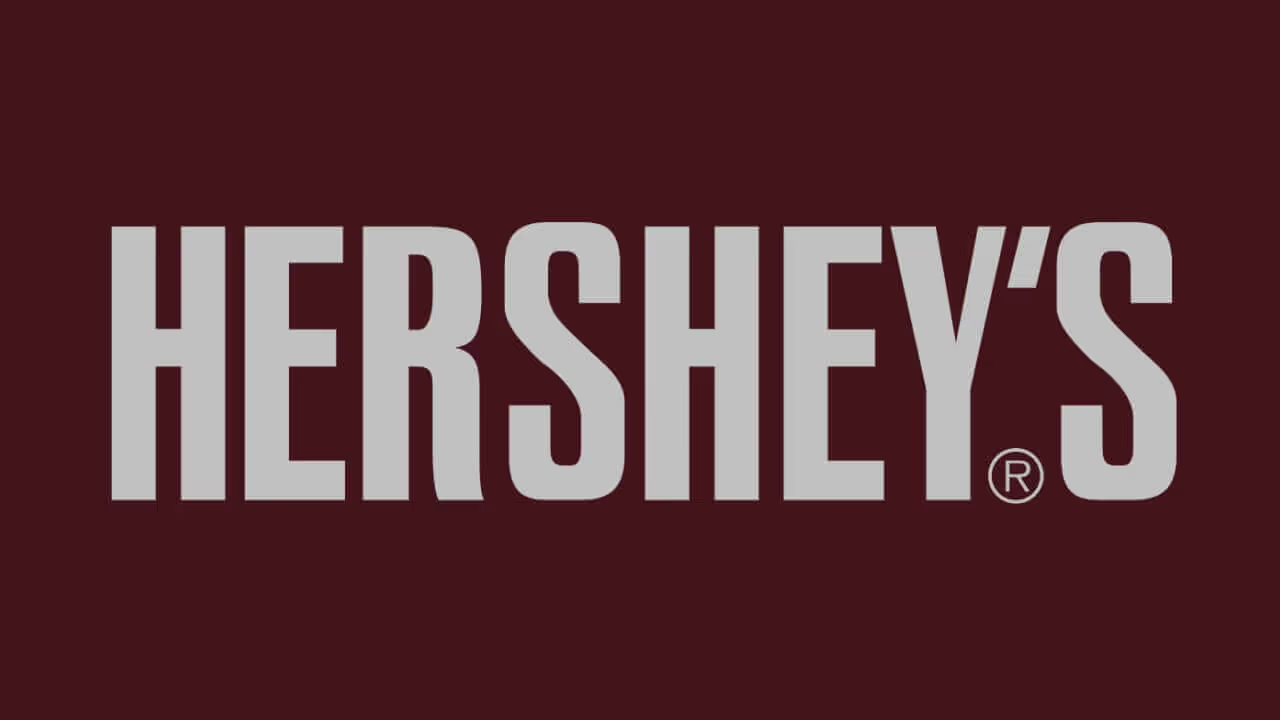Here’s what you’ll learn from Hershey’s strategy study:
- How to stay resilient, study a market and move when the timing is right.
- How to differentiate with a cost leadership strategy.
- How to adapt to market conditions and expand your product portfolio.
- How to become more proactive and respond to market trends faster.
- How to diversify while strengthening your brand.
The Hershey Company is one of the largest chocolate manufacturers and an American multinational company. Milton S. Hershey founded the company in 1894 and in 1927, he took it public.
Today, institutions own nearly 85% of the company and its CEO is Michele Buck.
Hershey’s market share and key statistics:
- Annual revenue of $8.9 billion in 2021
- Number of employees worldwide: 18,990
- Over 100 iconic brands around the world
- Total assets of $10.833 billion in 2022
- Market cap of 49.20 billion as of Feb 2023
If you want to know how Hershey’s became what it is today, grab a chocolate bar, and read on. Let’s explore how the company became a classic in the world of chocolate.
Humble beginnings: How did Hershey's start?
While Hershey’s story begins many years later, its roots tie back to the many failed ventures of Milton S. Hershey. It was these failures that led to becoming today’s famous chocolatier.
Print to Candy
Milton Snavely Hershey was born on 18th September 1937 and spent his childhood in Pennsylvania. Hershey was not too fond of school and dropped out at the age of 12, as soon as he had learned how to read, write, and do basic math.
While Hershey’s mother supported him in the decision, his father remained against it. He had Hershey working as an apprentice at a small newspaper. However, Hershey hated his time there and knew the writing industry was not meant for him.
In 1873, Hershey began an apprenticeship nearby, at a candy factory in Lancaster. Witnessing the world of chocolate, his profession of choice transformed into becoming a candy business entrepreneur. 4 years later, he opened a candy shop in Philadelphia by borrowing capital from his aunt and uncle, the Snavely’s.
Unfortunately, within 6 six years, the aftermath of the Long Depression caught up to his venture. Although sugar prices were soaring, Hershey could still not increase the prices of his products due to the lacking effective demand as the consumers barely had any money to spare. To make matters worse, Hershey’s father, Henry, came to his shop hoping to make amends and ask for capital for this new business.
While Hershey helped, Henry’s business venture failed, and eventually, Hershey was left with too high a debt to continue operating. Therefore, the shop was shut down after going bankrupt.
Learning The Secrets of Trade

Milton S. Hershey did not back down. He traveled to Denver, became an apprentice to a local confectioner, and learned how to make caramel. There he discovered a secret in the industry: fresh milk.
Instead of using the standard Paraffin Wax in caramel-making, the use of milk ensured the caramel was soft, smooth, and lasted longer on the shelves.
Hershey knew this could be his unique selling point if he was to break into the market with milk-produced caramel. Therefore, he loaned capital from his Aunt yet again, and immediately converted his newly learned skill into a method of earning as he began to sell caramel candies on the streets of New York.
The candies were a hit! The people of New York were unaware of milk-produced caramel, and soon after, his clientele grew. However, his father visited Hershey yet again, this time asking for investment for his cough drop business. Since the business did not take off well, Hershey was left with mounting debt and consequently, this venture too failed.
Disheartened but not losing hope, Hershey moved to his hometown, Pennsylvania. There, he founded the Lancaster Caramel Company.
Caramel to Chocolate
Pennsylvania had an abundant supply of milk due to the presence of dairy farms. This observation of plentiful resources created a business idea in the mind of Hershey; he could use the local milk to produce caramel candy yet again. Since the milk would now be local instead of the imported kind, as he had used in New York, his cost of raw materials would be considerably reduced.
By getting the other raw materials, like sugar, from Philadelphia, he began production and the venture proved successful. The consumers especially liked the addition of fresh milk in the candies, which gave it its distinct taste. The caramel was shipped across the globe as its consumer base grew far and wide.
However, Hershey knew there was an opportunity for growth. He noticed exceptional demand for his caramel goodies that featured chocolate, such as the chocolate-flavored and chocolate-dipped caramel. There he understood – Chocolate had potential.
In 1893, Hershey attended the World’s Columbian Exposition in Chicago. There, his intrigue for chocolate grew as he saw, for the first time, a machine creating chocolate. As the German owner, Lehmann, offered a chocolate bar to Hershey to try, he also explained how automation had considerably reduced the cost of chocolate production, making sure that chocolate was no longer a luxury to be enjoyed by only the wealthy.
Hershey was impressed. He also then realized why his sales in Europe were declining; people were switching to chocolate. Understanding chocolate was to be the future of the confectionary world, Hershey returned to Lancaster and founded The Hershey Company in 1894. He established a milk processing plant with the initial idea that he would begin the production of caramel-covered chocolate bars.
However, as the chocolate bars themselves became a huge hit, he decided to finally bid adieu to his caramel path and invest in solely chocolate, selling his Lancaster Caramel Company for $1 million in 1900. The time of the signature Hershey’s candy bar wrapped in the iconic brown and silver wrapper had begun.
Takeaway 1: Do Not Lose The Entrepreneurial Spirit – Ever!
Milton S. Hershey had humble beginnings, a myriad of failed businesses, and several bankruptcies before he stumbled onto the world of chocolate and was finally able to embrace long-term success. However, Hershey understood his interests lay in the confectionary world and did not fear to take risks.
Hershey apprenticed at many different confectionary shops to learn the secrets of the trade and advance his skills before identifying himself as a confectionary entrepreneur. Once he knew all that he had to, he observed a gap in the market in New York and landed in the city to sell caramel goodies.
Whether it was Denver, New York, Pennsylvania, or otherwise, the lack of capital or manpower did not hinder Hershey’s in his path. He borrowed, loaned, or invested in other businesses to gain capital and started from scratch many times before finally founding The Hershey Company in 1894.
Hershey's strategy creates the milk chocolate legacy
Hershey knew his potential for success lay in chocolate. But, instead of starting small, such as in his earlier ventures, he decided to go all in.
The Hershey Town
Hershey moved back to his hometown Derry Church, Pennsylvania, and invested his money from the sale of the Lancaster Caramel Company into the construction of a chocolate processing plant.
The factory was huge, and this was not all. Hershey wanted to create an ideal town for his workers. Hershey-led developments in the town, such as the Hersheypark offering leisure activities, became key to boosting employee morale.
By 1903, the factory’s construction was completed, but the signature Hershey’s milk chocolate formula was yet to be found. Hershey enlisted the help of an engineer, John Schmalbac, from his former caramel venture. Experiment upon experiment, Hershey and Schmalbac were trying to rid the basic chocolate problem – mix and chocolate don’t mix well.
The solution was found by producing condensed milk first and consequently using that in chocolate production. The result was a sweet chocolate with a tinge of sourness – i.e., the signature Hershey’s milk chocolate.
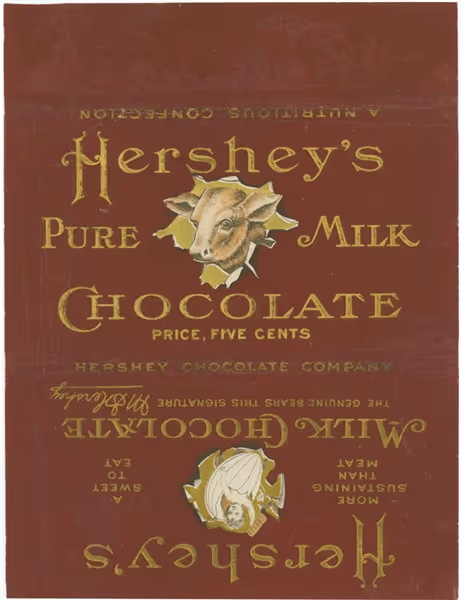
The addition of condensed milk also ensured the chocolate could be mass-produced at an exceptionally low cost, with the ability to stay in storage for long without spoiling. This reduced the price of chocolate, making the Hershey’s bar affordable for all – just what Milton Hershey had desired. In the first year only, the sales of the Hershey’s Milk Chocolate Bar exceeded $1 million, making it an instant success in the market.
A unique company strategy
Hershey discovered that the chocolate made with condensed milk was easy to mold, as it took the shape of its container seamlessly. Therefore, in 1907, a new bite-sized milk chocolate candy was introduced – the famous “Kisses”. These were small, conical, and flat at the bottom, giving them a distinct shape. Each was wrapped by hand in aluminum foil, and given their small size, was incredibly easy to eat and carry.
Considering the unique name of the product, Hershey’s Kisses also became a popular gift among couples, especially making sales on Valentine’s Day. In 1908, Milk Chocolate Bars with Almonds were also introduced, bringing the total product tally to 3 distinct, milk chocolate products.
It was then that Hershey decided on a strategy of mass production and low pricing. The three Hershey’s products were produced and delivered throughout the United States costing no more than a nickel! Yes, really!
The strategy worked as chocolate no longer remained a candy to be enjoyed by the wealthy only but instead transformed into a household favorite sweet. Courtesy of the move, the Hershey factory almost tripled in size by 1911 as it attained new heights!
The Opportunity in Cuba
While the chocolates did well across the country, a tragedy entered Hershey’s life – his wife passed away. In grief and needing some time to himself, Hershey went for a vacation to Cuba in 1916. Little did he know, another opportunity awaited him in the country.
Cuba was full of hospitable people, a welcoming environment, and to Hershey’s astonishment, abundant sugar cane fields. By the time he was leaving for Pennsylvania, he had decided he would build a sugar field in Havana, Cuba, and transform the area as he did for Derry Church.
Although William Murrie, the Vice President of The Hershey Company, was against Hershey’s decision, the plan went ahead, and fortunately so.
It appears that Hershey’s plan was meant for the long term, as it guaranteed an abundant supply of sugar through Cuba, and milk through Derry Church, enabling the supply of two core ingredients for chocolate production.
The World War and Hershey’s
A year later, in 1917, World War had begun and there was a major sugar crisis. As the commodity became scarce and expensive, Hershey’s was able to easily meet its production demands on its own. The company also managed to score a major contract from the U.S. Army for 2 million chocolate bars. This expanded their consumer base, and consequently the reach of the company, manyfold.
Takeaway 2: Find & Leverage Your Unique Selling Point (USP)
Milton S. Hershey’s plan to set up a confectionery business was clear; to set his business apart from his competitors, he had to create a USP. This stemmed from observation of the prevailing products in the market and their consumer response. Hershey’s strategy thereby became two-pronged; create a unique, signature milk chocolate and produce in large quantities with low prices to reach most consumers.
While the signature milk chocolate recipe was found with the help of a former engineer and by analyzing the benefits of condensed milk, the low price point was achieved by ensuring a seamless, self-owned supply of milk and sugar. Consequently, the chocolate was unique, delicious, and affordable, making it a crowd favorite and churning record-breaking revenue for the company.
The Hershey’s Product Portfolio Expands
The Hershey Company had made a name for itself in the American chocolate industry. However, the competitive world caught up to the brand very soon.
Competition Requires Strategy Change
While the signature milk chocolate allure gained momentum in the market, competitor companies soon launched their newest additions. In 1917, the Clark Bar appeared on the racks. Featuring a peanut butter inside and milk chocolate top, it was the first “combination” American chocolate bar and gained much acclaim.
Baby Ruth soon followed in 1920, with a distinct combination of milk chocolate, peanuts, caramel, and nougat. Mounds, Oh Henry! Candy Bar, and the Milky Way also gained consumer attention. To deal with the competition, Hershey decided to increase production. Earlier, Hershey’s Kisses were manually wrapped which took time. In 1921, machine wrapping was introduced which sped up the process considerably and is continued till today – wrapping over 70 million chocolates every day.
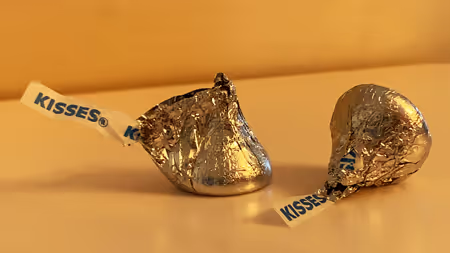
However, the company’s management soon realized that simply increasing production would not be enough to tackle the competition. New products must be added to the portfolio.
Expanding The Hershey’s Product Range
After extensive market research and competitor analysis, Hershey’s team knew peanuts were in demand with chocolate, as was proven with Baby Ruth and the Clark Bar too. Therefore, in 1925, Mr. Goodbar, a combination of chocolate with milk chocolate and peanut chunks, was introduced by Hershey’s. Featuring a distinct yellow background and red text, the chocolate bar stood out among the competition.
The next year, the rich and flavorful Hershey’s Syrup made its way into the market. Used in adding to milk, layering desserts, and consuming as is, the syrup was rich and decadent and soon became a crowd favorite. In 1928, the company also introduced semi-sweet dark chocolate chips, bringing its product portfolio up to 6 distinct, products.
Reese’s Peanut Butter Cups Enter The Picture
By the 1920s, the Hershey’s empire had expanded manifold, and the introduction of Reese’s Peanut Butter Cups thrust it into a new profitable era. The cups were created by Harry Burnett Reese in 1928.
Reese had worked the Hershey’s dairy farm as a dairyman from 1917. When the factory was completed, Reese moved to work there and produced an assortment of candies and chocolates. Each was created using Hershey’s milk chocolate and was advertised and sold in the stores of Lancaster as “Made in Hershey.”
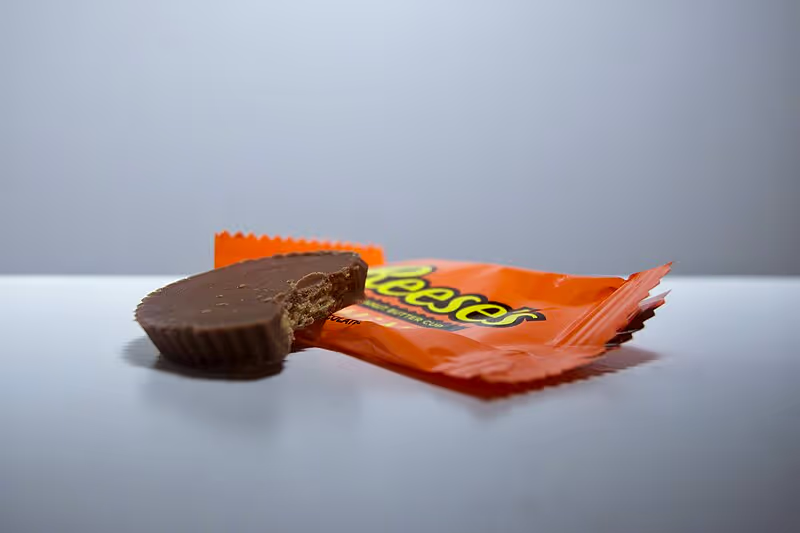
However, by 1926, Reese left the Hershey factory to build his own, which today acts as a subsidiary of The Hershey Company. Post-war, when competition and rising prices were hindering Hershey’s turnover, Reese created the Peanut Butter Cup. Featuring a milk chocolate cup base filled with peanut butter within, the confectionary masterpiece required less sugar than most candies at the time.
In addition, it was a unique sweet as most people termed peanut butter as a food item for those who couldn’t digest meat at the time. The cups were an instant success, so much so that Reese halted production of other confectionary items and focused on Reese’s Peanut Butter line only.
As their profits increased, Hershey did not treat Reese as a threat. Instead, Milton decided to supply milk chocolate for the cup base; thereby forming a close alliance with Reese’s company. In 1956, Reese passed away and left the company to his six sons. 7 years later, the company merged with Hershey in the form of a tax-free albeit stock-for-stock merger. By 1969, the peanut butter cups had become a bestseller for The Hershey Company and continue to go strong today.
Takeaway 3: Don’t hesitate to rethink your strategy
In the initial years, the Hershey's strategy was simple: Focus on a few products and ensure the production of quality confectionary items. However, as competition beckoned in the 1920s, the same strategy that was successful in launching the Hershey brand, no longer worked. In response, Hershey’s took no time to adapt to the prevailing market conditions and decided to invest in expanding its product portfolio.
From Mr.Goodbar to chocolate chips and beyond, the company created a name for itself beyond the realm of milk chocolate too. This helped attract the clientele that liked dark chocolate (such as with the chocolate chips) as well as combination chocolates (i.e., through Mr. Goodbar). Had Hershey’s remained stringent to their existing 3 products and not adapted to competition, perhaps the grand Hershey name that we see today might not have been so.
Responding To Competition
While the entry of new competitors in the chocolate industry remained unrestricted, Hershey continued to experiment with new confectionary items. The launch of Krackel in 1938, a chocolate bar with crisped rice, was one of them.
The M&M’s Introduction and Departure
As the executive management at The Hershey Company had grown, it was beyond being the one-man show as it had started off as with Milton S. Hershey. In the late 1930s, the son of Hershey’s President William F.R. Murrie, called Bruce Murrie, decided to join hands with Forrest Mars to create a new kind of chocolate. These were little, button-shaped chocolates with a hard and colorful, sugar-coated exterior and the same, delicious milk chocolate interior. The chocolates were named after Mars and Murrie and called M&Ms – the same M&Ms we addictively snack on today.
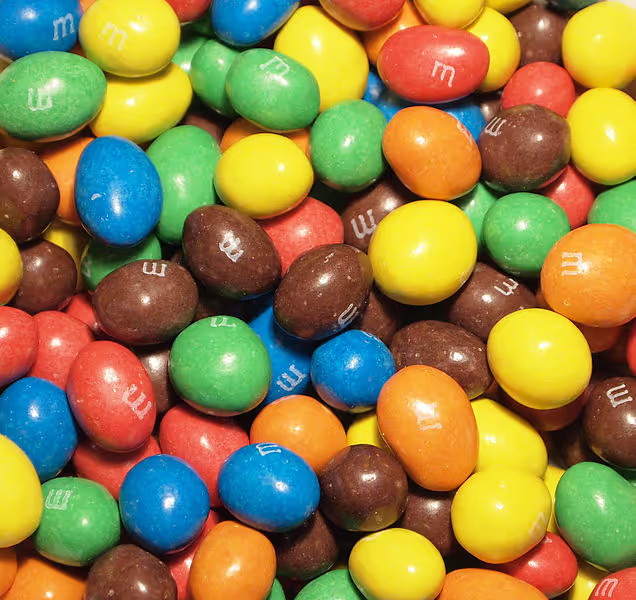
However, Murrie only held 20% ownership of the new product. Therefore, while M&Ms had begun as a joint creation of Mars and Hershey, it was bought out by Mars in 1948. This was a loss for Hershey as the M&Ms' demand grew and curated a distinct clientele across the globe, consisting of a varied demographic including children as well as adults.
World War II and Military Chocolate
It seemed that while opportunities had not been on Milton S. Hershey’s side in the initial years of doing business, the Hershey confectionary business covered for the failures in the past. In 1939, World War II broke out. While many businesses went bankrupt or were disturbed greatly, chocolate boomed.
Military chocolate had been introduced since the first World War and did well as a military food item since it was packed with energy and nutrition. Known as Field Ration D, the chocolate was packed in the U.S. military ration. However, the bar was intentionally made to not be too sweet or delicious to ensure the troops would not consider it a snack nor would be tempted to eat it.
During World War II, Hershey created a military chocolate bar for American troops that wouldn’t melt easily in the tropical heat, so as to last longer and provide greater utility.
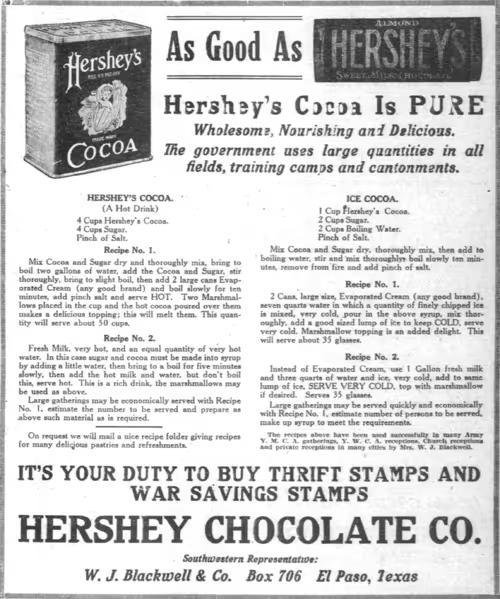
Hershey Decides On Diversification
The end of the World War marked another end for Hershey’s legacy; Milton S. Hershey passed away in 1945. As the executive team of the company sprang into action, they kept Hershey’s plans and trajectory intact and as per the founder’s set the trajectory for many years. However, in the late 1960s, when the plan slightly changed.
The new CEO was William Dearden. He developed a corporate strategic plan for the company which included diversification as a key aspect. Thereafter, Zimmerman and Simmons were entrusted with the task of researching investments with potential.
The company acquired two pasta businesses: San Giorgio Macaroni Company and Delmonico Foods. Almost every U.S. state was supplied with Hershey's pasta with the exception of Maine, Michigan, and New Hampshire.
The pasta business was quite profitable for the company for a few years. But by the late ‘90s, the profits went down considerably as Italian exported pasta, and the American Italian Pasta Company entered the market. When sales reached $400 million in 1997, Hershey decided to sell its pasta division instead of investing for improvement. Consequently, in 1999, the pasta division was sold for $450 million in cash to the New World Pasta Group.
Disrupting Competition in the United States
As the chocolate fame grew, so did the competition. From Mars to Milky Way, the target audience began to divide their consumption among chocolates from various companies, and so The Hershey Company management had to devise a new strategy. This was when geographically bounded acquisitions became a part of the Hershey portfolio.
In the 1960s, Rowntree’s used to produce many confectionary items, of which two included Nestle and Rolo. In 1969, Hershey purchased the right to produce and market these two consumer favorites in the United States. This helped slim down American competition.
Although Nestle acquired Rowntree’s in 1988, the company was still required to honor the initial agreement made with Hershey, until The Hershey Company’s ownership changed hands. Similarly, in 1988, Hershey acquired the rights to produce and advertise many products of Cadbury (except for chewing gums and mints that were headed by Mondelez International). S
Consequently, Hershey added barriers to the geographical expansion of its competitors into the United States, while simultaneously capturing the clientele of consumer favorites like Kit Kat and Dairy Milk, etc.
Takeaway 4: Remain updated with competitor research.
While Hershey’s had helped change the image of chocolate being a solely “luxury” consumer product, many competitors had cashed in on changed perceptions. This made the chocolate industry a widely contested one and divided the consumer base into multiple factions. The Hershey Company management understood this and actively changed their corporate strategic plan to be reactive as well as proactive with competitor strategies.
There was consistent research on brimming chocolate trends in the market, and Hershey immediately caught on. This was through their own manufacture as well as acquisitions. For example, when the Kit Kat trend rose, Hershey’s gained the rights to Kit Kat production in the U.S. When the pasta market became too financially burdening, the company let their pasta division loose. Decisions like these helped maintain cash flow and sustain consumer interest in Hershey’s brand.
Acquisitions & The Pathway Forward
The Hershey Company began as a milk chocolate brand. However, its journey to becoming an empire concerning chocolate as well as many other diverse items soon followed.
The One-of-a-Kind Hershey’s Chocolate World
Hershey’s did not only provide an off-the-rack chocolate experience. Instead, the company was famous for providing behind-the-scenes intel too. What does that mean? Plant tours, of course. The Hershey Company famously provided factory tours as they showed children and adults alike how their signature milk chocolate was made (cue, Charlie and the Chocolate Factory). However, when the tours reached maximum capacity, the company decided to go a different way. On June 30th, 1973, the Hershey’s Chocolate World was created in Hersheypark Drive, Pennsylvania.
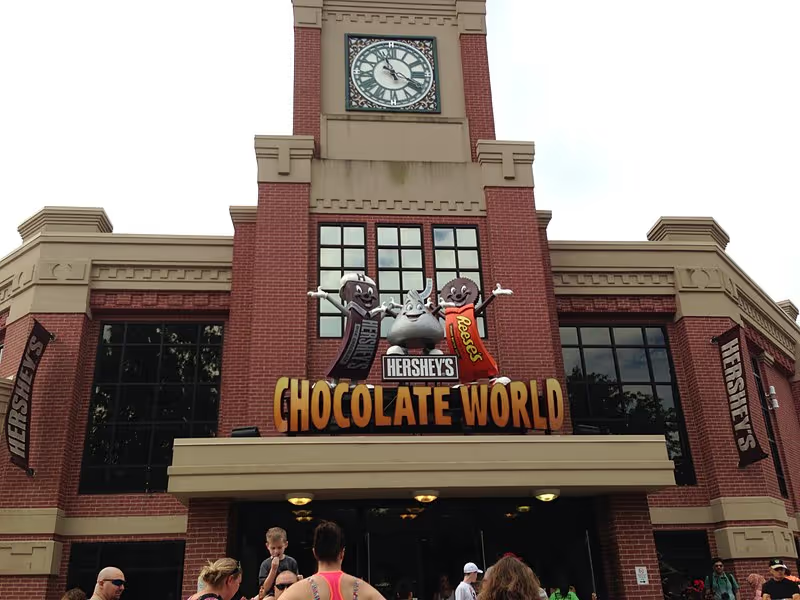
There were several chocolate rides, including the tour of chocolate creation. In only the first year, Hershey’s Chocolate World made a staggering $1.4 million, and to date continues to garner visitors from far and wide.
Now, the park has expanded to include shops and restaurants, as well as attractions like Create Your Own Candy Bar, Hershey’s Great Chocolate Factory Mystery (4D), Hershey’s Unwrapped: A Chocolate Tasting Journey, etc. Today, Hershey’s Chocolate World is situated in 5 distinct locations, including Singapore and Niagara Falls.
The Acquisition Timeline
The Hershey Company’s growth continued to foster thanks to its innovative product development and acquisition of other brands.
The late ‘90s and early 2000s were the years of varied acquisitions for the company, thereby diversifying Hershey’s brand portfolio.
- 1986: Hershey’s acquired Luden, a cough drop brand, as a move to diversify their portfolio, but sold it soon after. However, the 5th Avenue Bar of Luden, consisting of a peanut butter crunch of layers, is still produced and marketed by The Hershey Company and continues to be available at small retailers.
- 1996: It acquired the Leaf Candy Company from Huhtamaki Oy which was barely managing to stay in business. The deal involved Hershey’s selling its European candy operations to Huhtamaki and strengthening its operations in North America with Leaf Candy. Moreover, Leaf’s Jolly Rancher brand of confections also helped Hershey’s extend its portfolio beyond chocolates.
- 2011: the company acquired Brookside Foods Limited which along with producing traditional chocolate-covered nuts, sold unique chocolate-covered fruit juice pieces, allowing Hershey’s to add a distinct product to its list.
- 2015: The Hershey Company acquired Krave Junky, a protein snacks brand. It was another attempt by Hershey’s to expand its offering beyond chocolates. However, the venture didn’t prove fruitful and Krave resold it to its founder in 2020.
- 2016: Hershey bought the famous barkTHINS, a fair trade chocolate snacks brand that had been an instant hit ever since it hit the shelves in 2013. With trends suggesting considerable growth, the acquisitions were expected to earn Hershey’s an additional $65 million to $75 million in revenue.
- 2017: Bought Amplify Snacks Brand for $1.6 billion, further cementing Hershey’s position as a snacking brand and broadening its product mix.
- 2018: Acquired Pirate Brands, a snacks products company that focused on offering healthy products. With the takeover, Hershey’s could project a healthier image of its products and the brand overall.
From confectionary items to snack products, the Hershey brand grew considerably.
The Hershey Company Today
Recently, in June 2021, Hershey purchased the confectionary business Lily’s for $425 million, adding another feather to their cap. In November, they announced the purchase of Dot’s Pretzels as well as Pretzel Inc. for $1.2 billion, consequently expanding their snacks empire. This also came on the back of stellar few years for the Pretzels brand during the COVID-19 situation with the demand for snacking items on the rise.
In addition to Reese’s, Kisses, Kit Kat, and the signature Hershey’s, the company also heads Twizzlers, Jolly Rancher, Almond Joy & Mounds, and Payday, garnering a diverse and huge market share in the confectionery industry.
To attract Gen Z, the company has also built a user-friendly website and continues to bring improvements in its product range with creative names. The creation of the crunchy, creamy candy bar “Whozeewhatzit”, with the tagline Funny name. Serious taste. shows how the company has adapted multiple products in-line with its target audience to create a buzz.
The company has also created Hersheyland, a food blog/backing resource with different, delicious recipes of goodies you can create with Hershey’s products.
Takeaway 5: Think Bigger
The Hershey brand primarily focused on chocolate. However, instead of simply becoming a chocolate items brand, it expanded its vision to become an empire that children and adults alike would love.
The acquisition of various non-chocolate brands such as Pretzels, and the creation of Hershey’s Chocolate World and Hersheyland were proof that The Hershey Company had expanded its trajectory, instead of halting for sustenance when it became a major chocolate brand in the world.
Why is Hershey's so successful?
Today, The Hershey Company which began after multiple failures and bankruptcies has transformed into a billion-dollar empire and one of the biggest chocolate manufacturers in the world. While its headquarters are in Hershey, Pennsylvania, the chocolates have surpassed boundaries to attract and fulfill consumers from over 60 countries. The founder also created a school for orphan boys, that was given the entire Hershey fortune upon his and his wife’s passing, while the company took Milton S. Hershey’s legacy forward.
Growth By Numbers
The company was founded in 1894, about 127 years ago, and was known as the Hershey Chocolate Company. Its growth can be assessed through a look at the company’s numbers:
Strategic Takeaways
With a series of ups and downs, Hershey’s journey contains many strategic takeaways for budding entrepreneurs and chocolatiers across the world.
- Do not lose hope over failure
Milton S. Hershey did not start out with a mission to build a chocolate empire. In fact, he was far from it. He dropped out of school, went to work in printing, had numerous failed candy businesses, and multiple bankruptcies. However, since his passion lay in confectionery items, he was dedicated to never backing down. When the Great Depression arrived and sugar prices were soaring, the business evaluated and formed strategies to survive. Paving a path from caramel to candy and then chocolate, The Hershey Company did much to achieve its position today; and continues to do so.
- Set yourself apart
When Hershey began producing chocolates, the item was looked upon as one for the upper class. However, they changed their brand image by producing budget-friendly chocolate courtesy of their low cost and wide supply network. The introduction of chocolates for everyone brought Hershey’s in the eyes of most sweet lovers in the area. Although at one point, Hershey held the most market share of the milk chocolate industry, it was not a monopoly. Since barriers to entry remained low and new competitors continued to enter, Hershey focused on creating a loyal clientele, regardless of its size. This shed light on Hershey’s formula, perfected after help from a former engineer and Milton Hershey himself, and ensured the company and its products stood distinct from the others.
- Adapt to prevailing industry conditions
Initially, Hershey only dealt in 3 products, all concerning milk chocolate. However, as competition grew and peanut butter garnered consumer attention, the company immediately made decisions to maintain market share. This included not considering Reese’s as a threat but an opportunity instead and thereby supplying its milk chocolate bases. Later, when Kit Kat and Rolo attracted a wide clientele, Hershey also acquired their U.S. divisions to keep the American turnover rolling.
- Create responsive strategies
A primary reason behind the success of the Hershey Company lies in its strategy making. The management understood that when competition beckons, creating a similar, competing product isn’t the only solution. Sometimes the company did acquisitions, whole ones such as Y&S and Pretzels etc., other times it acquired geographical divisions like Cadbury and Kit Kat in the U.S. In other situations, such as its Pasta division, the company did a cost-benefit analysis and realized the profits of keeping the sector were not worth the cost of sustaining it. Therefore, at each point in the tenure, the company’s executive management created responsive strategies after careful consideration of prevailing conditions and potential outcomes.
- Diversification is key
The Hershey Company’s journey teaches one that when you want to create a company, you may focus on a particular product line or sector. However, building an empire requires spreading your wings far and wide, and this makes diversification mandatory. Hershey began as a chocolate company focusing on 3 products and now has dived into caramel, peanut butter, meat, licorice, and even beer. By diversifying into multiple product types and lines, Hershey ensures a diverse risk spread and consistent cashflow. If one brand may not be doing well, the other can cover up, and vice versa. Having its stakes in multiple product lines has also expanded the company’s reach, and therefore its consumer base, making Hershey’s a brand that is known around the globe and is a household favorite for many.


